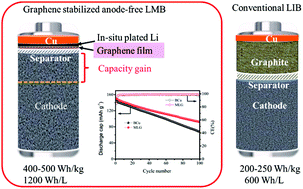Multilayer-graphene-stabilized lithium deposition for anode-Free lithium-metal batteries†
Abstract
The will to circumvent capacity fading, Li dendrite formation, and low coulombic efficiency in anode-free Li-metal batteries (AFLMBs) requires a radical change in the science underpinning new materials discovery, battery design, and understanding electrode interfaces. Herein, a Cu current collector formed with ultrathin multilayer graphene grown via chemical vapor deposition (CVD) was used as an artificial layer to stabilize the electrode interface and sandwich-deposited Li with Cu. A multilayer graphene film's superior strength, chemical stability, and flexibility make it an excellent choice to modify a Cu electrode. Fabricating an anode bigger than the cathode improved the alignment of the electrodes during assembly, minimizing interfacial stress. Here, 19 mm electrodes when paired with a commercial LiFePO4 cathode (mass loading: ∼12 mg cm−2) delivered the first-cycle discharge capacities of 147 and 151 mA h g−1 for bare and multilayer-graphene-protected electrodes, respectively, which could alleviate the big hurdle (initial capacity loss) in anode-free batteries. After 100 round-trip cycles, bare Cu and multilayer-graphene-protected electrodes retained ∼46 and ∼61% of their initial capacities, respectively, in an ether-based electrolyte at the rate of 0.1 C.



 Please wait while we load your content...
Please wait while we load your content...